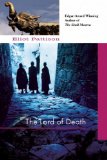A Short History of Tibet
This article relates to The Lord of Death

Tibet, a remote region along the southwestern border of China, sits at 15,000 feet above sea level between the Himalaya and Kunlun mountain ranges. The first recorded king of the region was Srong-btsan sgam-po, who is credited with introducing Buddhism to Tibet around 640 AD. He and his descendants ruled over a unified Tibet through the 8th century, but the empire eventually collapsed into a collection of small independent kingdoms.
 Map of Tibet
Map of Tibet
click for larger image including key
|
When Genghis Khan's forces marched through much of Asia around the turn of the 13th century, Tibetans managed to retain a good deal of autonomy and acquire some political influence by agreeing to pay tribute to the Mongols. When the Mongol empire collapsed, Tibetans asserted their independence from China, and power within the region became concentrated in the hands of a spiritual leader known as the Dalai Lama.
Centuries later, Tibetan history was again influenced by violence from the north, when Chinese imperial forces intervened in a dispute between Mongol warlords and occupied the capital, Lhasa. The Chinese remained in control of Tibet until 1911, playing a role similar to that of a feudal overload. The current Chinese leadership uses this historical relationship to justify its occupation of Tibet.
Tibetans expelled the Chinese troops from Lhasa in 1911 after a revolutionary uprising within China against the Ching dynasty. They again declared independence in 1913 under the 13th Dalai Lama, Thupten Gyatso (1876–1933). China was too busy with its own civil wars and war with Japan to be able to devote resources to regaining the territory until the People's Republic of China (PRC) invaded Tibet in 1949. A Tibetan delegation was forced to sign the "17-Point Agreement for the Peaceful Liberation of Tibet" on May 23, 1950, which essentially turned Tibet into a Chinese colony. 16-year-old Tenzin Gyatso, the 14th and current Dalai Lama, assumed full powers as Head of State on November 17, 1950. On September 9, 1951, thousands of Chinese troops marched into Lhasa. The PRC began a program of collectivization, closing monasteries and taking their land and wealth.
Led by monks, the Tibetans revolted in 1956, waging guerrilla warfare against their Chinese occupiers for the next three years. The Chinese responded in 1959 by razing entire villages and monasteries and arresting thousands of men, women and children. Almost all autonomy was revoked, Lhasa lay in ruins, and the Dalai Lama was forced to flee.
Tibet's autonomy continues to be a subject of international debate. The Chinese government remains in control, and maintains that they're improving the quality of life for Tibetans. The Tibetans, however, feel their culture and way of life are being systematically destroyed and persist in demanding independence from China.
The Dalai Lama, winner of the Nobel Peace Prize in 1989, lives in exile along with at least 100,000 other Tibetans. He continues to work for a non-violent resolution of the conflict between China and Tibet.
Filed under Places, Cultures & Identities
 This "beyond the book article" relates to The Lord of Death. It originally ran in July 2009 and has been updated for the
June 2010 paperback edition.
Go to magazine.
This "beyond the book article" relates to The Lord of Death. It originally ran in July 2009 and has been updated for the
June 2010 paperback edition.
Go to magazine.
This review is available to non-members for a limited time. For full access become a member today.
Membership Advantages
- Reviews
- "Beyond the Book" articles
- Free books to read and review (US only)
- Find books by time period, setting & theme
- Read-alike suggestions by book and author
- Book club discussions
- and much more!
-
Just $45 for 12 months or
$15 for 3 months.
- More about membership!

 Map of Tibet
Map of Tibet![]() This "beyond the book article" relates to The Lord of Death. It originally ran in July 2009 and has been updated for the
June 2010 paperback edition.
Go to magazine.
This "beyond the book article" relates to The Lord of Death. It originally ran in July 2009 and has been updated for the
June 2010 paperback edition.
Go to magazine.





